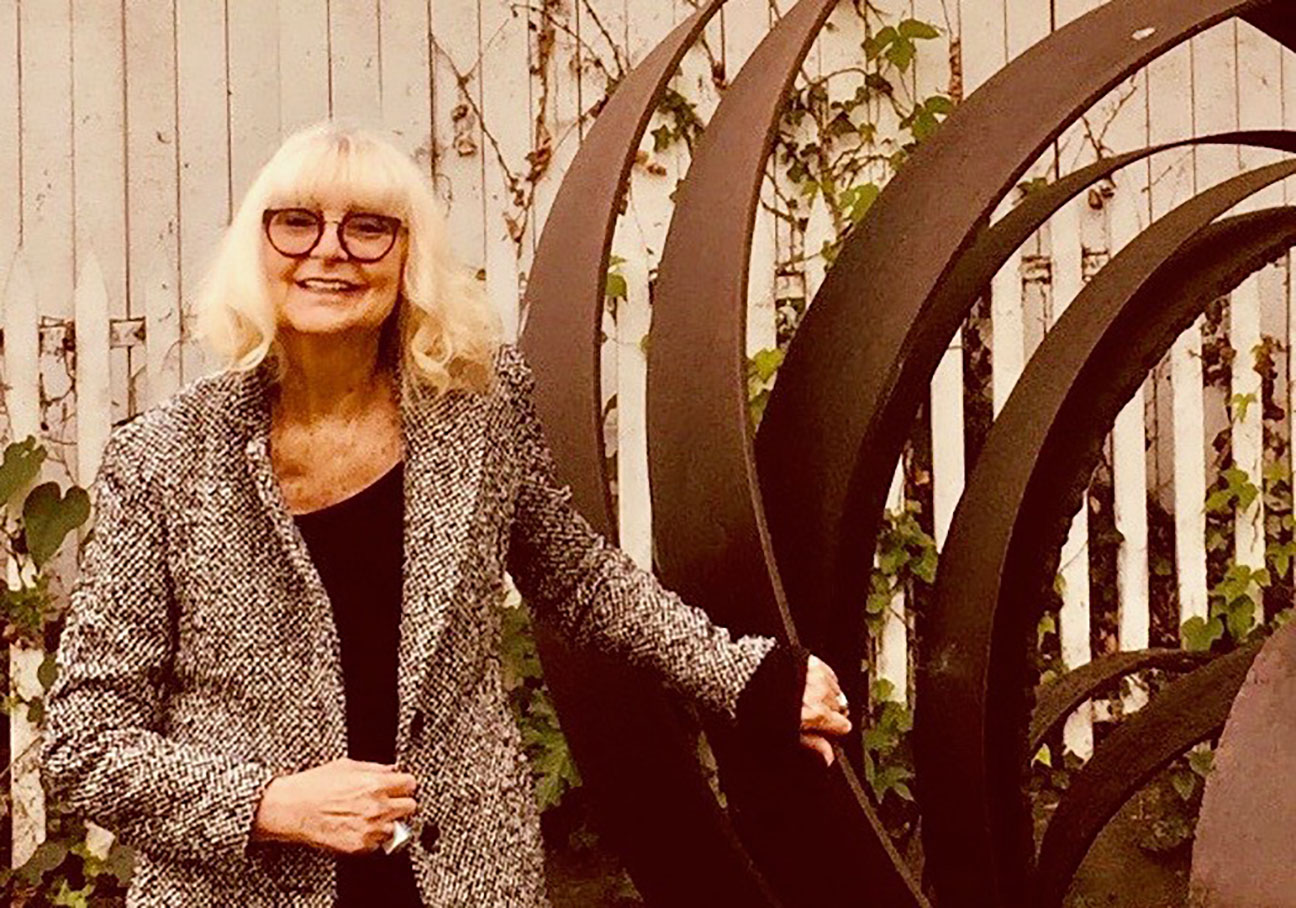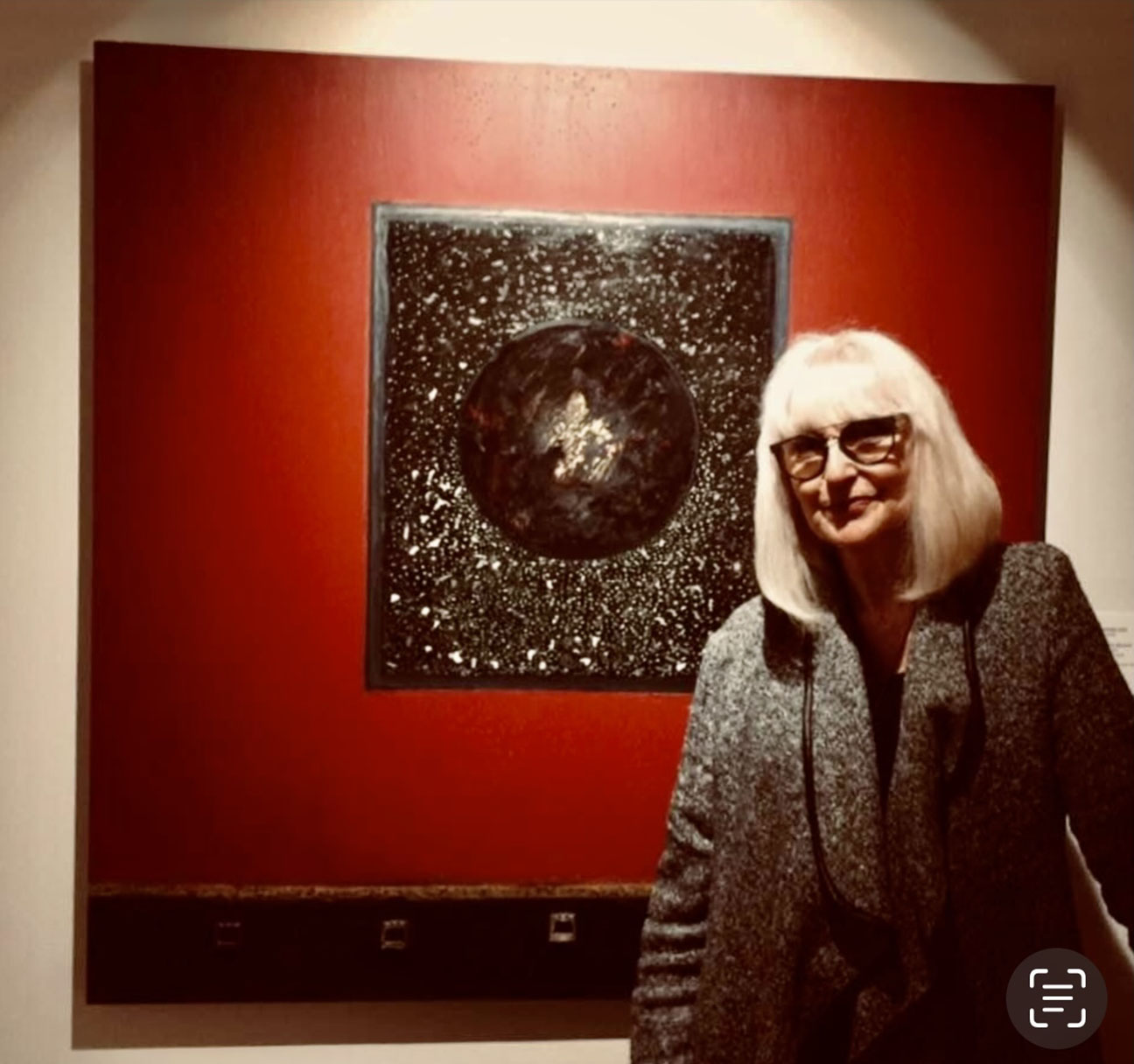| FEATURED
By Joe Livernois
Removing. Subtracting. Less is more. The mystery that lies beneath the surface, the matter that has been removed, is as important as what remains.
It’s how Stefani Esta defines her art. Her sculptures are big and heavy and solid — steel and stone — but she grinds and gouges and carves, applies chemicals and paint before removing it and adding it all over again. She says she trusts the process will eventually reveal what wants to be discovered.
The process of subtraction might describe her art, and lately it defines her life.
Esta is showing her work at the Monterey Museum of Art with an exhibition that opens on Friday. She won’t be at the opening, a late-minute decision based on pandemic precautions. “I have to keep everybody safe,” she says during a telephone interview from her new home in New Hampshire.
She feels bad about it. The opening would have been her reunion with her Central Coast friends, a chance to revisit her bold public work, two pieces on permanent display on the museum lawn, across Pacific Street from Monterey City Hall.
(Editor’s Note: While Esta was unable to travel for the opening of her exhibit, she has recently returned and is visiting with friends and admirers at the museum.)
Not long ago, she worked with steel and stone in a huge studio, producing tonnage of work that depicted abstract energy and the power of the spaces between. Today she moves around in a powered wheelchair, as Parkinson’s disease subtracts and erodes her strength. She recently moved to New Hampshire, so that daughter Heather may care for her.
The Parkinson’s might seem like a cruel fate, but she literally raised the poster child for physical disabilities and she says she learned much about resilience and happiness from her son, Ben Spangenberg. Her son was born with spina bifida, and her middle years were spent caring for and advocating on behalf of Ben. Her son is a super-achiever: He was a young spokesman for the March of Dimes who graduated from Cal, who interned for then-Rep. Sam Farr and who now advocates on behalf of the disabled with RespectAbility in Washington D.C.
While getting him to countless medical appointments, including 11 operations during his first 16 years, and to public appearances for his role as a March of Dimes spokes-boy, Esta continued to produce art. She says Ben inspired her.
Now, after devoting almost two decades of her life tending to the daily needs of a boy who grew to become an independent man, Esta needs the same sort of assistance.
“It’s not like I didn’t understand what Ben went through,” Esta says. “I did. I learned from the best because I learned from Ben. He is so dear, so sweet and so loving.” Spangenberg doesn’t feel sorry for himself, and Esta says she will not wallow in self-pity.
Other than the disappointment that she is unable to attend the opening of her exhibition this week, she thinks of herself as lucky. At Ben’s birth, doctors told her that he would likely live in a vegetative state if he lived at all. Esta says her Parkinson’s has not triggered a severe mental depression, which is a natural brain-chemical reaction common among those living with Parkinson’s.
Enlarge

Esta was raised in Southern California, the daughter of Tonia Nagle, a fine artist and instructor from Krakow, Poland. As a young adult, Esta tagged along with her mother to a life drawing class at the Arts Institute in Laguna Beach. They sketched the human form; they were bonded by their interest in art. When her mother died, Esta continued to attend the class.
In the next room, an Italian artist kept a sculpture studio. She was blown away by his work, spending hours watching the phases and the processes that went into the creation of stone art. He called her one evening, and invited her to take his class.
“I heard myself saying, ‘maybe when I’m older,’ and then I heard myself repeating my mother’s words and started the sculpture class next day,” she says.
She had two daughters who were ready to go off to college when she remarried and had Ben.
The pregnancy was difficult and she went into labor early — too early. She was given medicine to stop labor and she moved to another hospital. As he was delivered by Cesarean, doctors found the umbilical cord was wrapped around his neck, he was turned upside down in the womb and a brittle leg was broken during delivery. Doctors had told Esta to expect the worst. She elected to stay conscious during the procedure, telling doctors she wanted to see the boy if he died soon after delivery.
“But he had the most beautiful eyes,” she says. “He was a beautiful baby and I knew that everything was going to be alright.”
The family moved to Palo Alto in 1987, and Esta opened her gallery while navigating the difficulties of seeing Ben through his elementary school years. Some of the schools were better than others, and some administrators were more accommodating than others, but Esta says she decided she wouldn’t be “the squeaky wheel that doctors and teachers hate.” She adopted an attitude of collaboration with others, knowing she couldn’t afford to alienate people who wanted to help.
Her career grew as her work evolved in Palo Alto. With Martha Branner, she opened a gallery that showcased new talent, and she threw herself into her work.
“Stefani has an uncanny ability to feel what’s real, find the essential pulse of a thing, and then find the magic,” says her friend and colleague, Kris Swanson of Carmel Valley. ”She’s stubborn and visionary, with a grace most of us could not maintain under the circumstances she’s experienced.”
Esta divorced and moved to Carmel with Ben in 1994, opened a studio in Sand City and started to incorporate steel into her sculptures. Ben thrived in Carmel schools, but it was his experience at Cal that helped wean him from his mother. Administrators there insisted that he work with aides, to learn how to live independently.
And then, cruel fate. She started to lose control of her own body. She didn’t have the strength to produce her signature work. The decline continued and she spent a year with Heather, in New Hampshire, and was eventually told she had Parkinson’s. She returned, for a while, and lived in Monterey until recently.
Enlarge

Esta was a neighbor, the elegant woman who moved about my Monterey neighborhood in her power chair. I can’t recall how I learned about Ben, but when I did I knew I wanted to write a story about him so I reached out to her to make the connection. Voices carried the story in 2019.
Since then, Esta’s condition worsened. She and her family determined last year she can no longer care for herself, so Heather and her husband Ramsey agreed to move her to their New Hampshire home.
Neighbors gathered to help with the move. We assisted with a yard sale, moved her artwork to a storage area in Sand City and filled a pod with her personal belongings for delivery to the East Coast. She was leaving, but she knew she wouldn’t be gone long, that she’d return in January for the opening of her exhibit at the Monterey Museum of Art.
She was a neighbor and we knew she was an iconic local artist, but few of us in the neighborhood got to know her until her final days in Monterey.
We were struck by her kindness and by her gracious spirit. She is unlikely to work with stone and steel again, but she is now learning an entirely new genre in digital creative arts.
In the days before Esta left for New Hampshire, an acquaintance of mine, Dawn Sherman, coincidentally happened upon one of Esta’s works, entitled Calling, on the lawn at Monterey Museum of Art. Unsolicited and spontaneously, Sherman narrated a three-minute video that captured her awed response to the sculpture, which she posted to Facebook. Beyond the “form, movement and shape,” Sherman said, “I start looking at the spaces in between. And with the spaces in between she has created something of fractal beauty.”
I showed the video to Esta; she was gratified that another artist understood what she was trying to achieve. This is what she says in the artist statement written for her exhibition: “By adding and removing again and again, I am able to reveal what wants to be discovered.”
She is speaking of her art, but she has also learned that discovery reveals itself to those who adopt the process of adding and subtracting.
Stefani Esta’s work will be on exhibit at Monterey Museum of Art, 559 Pacific St. in Monterey, from Friday to March 26. The museum is open between 11 a.m. and 5 p.m. Thursdays through Saturdays.
Featured image: Stefani Esta with ‘Calling,’ her work on permanent display at Monterey Museum of Art | Provided
Have something to say about this story? Send us a letter or leave a comment below.
